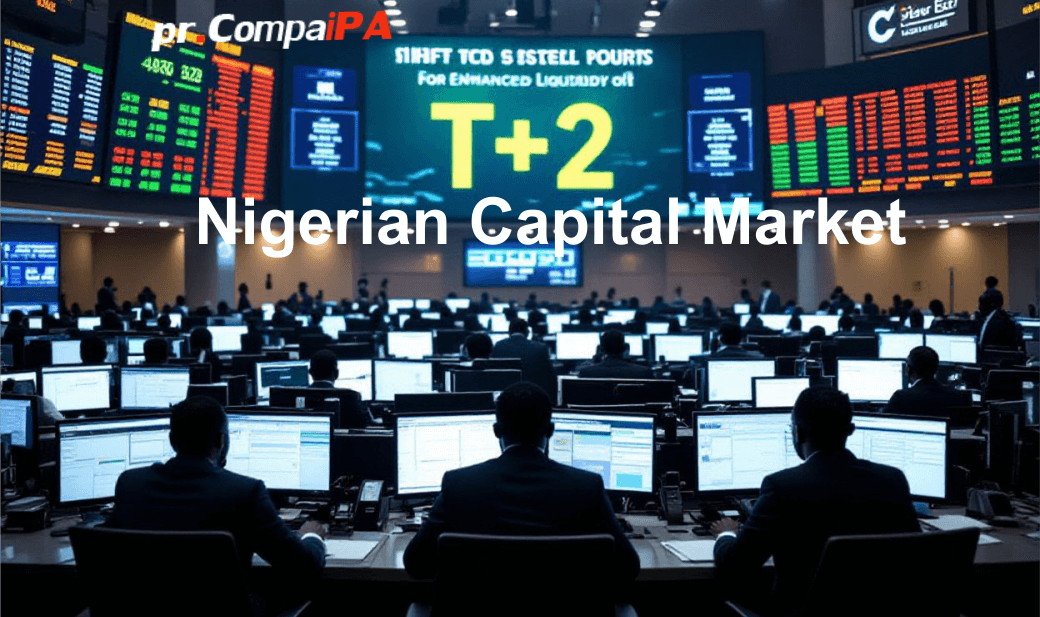Nigerian Capital Market Adopts Faster T+2 Settlement Cycle for Improved Post-Trade Efficiency
Settlement cycles in leading markets now typically run on T+2, and Nigerian capital market is finally locking into that same rhythm, which directly affects how fast you get your cash or securities after a trade. You’re moving into a market environment where counterparty risk is cut down, your capital isn’t stuck as long, and trades feel a bit less nerve-racking when volatility spikes. This shift can boost liquidity for your strategies, let you recycle funds quicker, and tighten up post-trade efficiency so your operations team has fewer headaches and nasty surprises.

Key Takeaways:
- Picture a trader closing a deal on Tuesday and actually seeing it wrapped up by Thursday instead of dragging into the next week – that faster T+2 settlement rhythm cuts down the time trades sit in limbo, where market swings and counterparty issues can cause trouble.
- Shorter settlement cycles typically mean lower counterparty and systemic risk, so a T+2 shift helps clean up a lot of that “what if the other side fails” anxiety that used to hang around for longer under T+3.
- Global investors are way more comfortable when markets speak the same post-trade language, so lining up with T+2 like the US and Europe can make Nigeria look less like an outlier and more like part of the main crowd, which quietly nudges up cross-border flows over time.
- Liquidity usually breathes easier when cash and securities come back into circulation faster, so with a T+2 cycle, active traders, market makers, and fund managers can recycle capital more quickly and tighten spreads a bit.
- Back-office teams and brokers feel this shift the most, because they need tighter operations, better reconciliation tools, and smoother straight-through-processing if they want to avoid settlement fails once everything is on a 2-day clock.
- Clearing and settlement infrastructure has to step up its game too – stronger risk management, better collateral practices, and sharper netting processes all become more important when there’s less time to fix errors or chase missing documentation.
- In the bigger picture, moving to T+2 is one of those quiet but meaningful reforms that can support future upgrades in market classification, make local assets more benchmark-friendly, and set the stage for even more advanced post-trade changes down the line.
What’s this T+2 Settlement Cycle, Anyway?
The Basics: How It Works
In most major markets today, over 90% of equity trades now settle on T+2, and Nigeria is sliding into that same groove. T+2 simply means if you trade on a Monday (that’s your T, or Trade Date), the actual exchange of cash for securities wraps up by Wednesday, not hanging around until Thursday or Friday. So you hit “buy” or “sell”, your broker executes, the exchange confirms, and within two business days, the Central Securities Depository and the clearing house have pushed securities into your account and cash into the seller’s account. It sounds simple, but there are a ton of pipes, checks, and reconciliations humming quietly in the background.
What this does for you is shorten the window where you’re exposed to all sorts of weird in-between risks. You still trade in real time, your order gets filled in seconds, but the legal transfer of ownership and cash – the settlement – is now locked in faster. If you’ve ever had to wait anxiously for funds to “clear” before making your next move, T+2 is basically cutting that waiting room in half, which gives you more predictable access to both your money and your securities.
The Basics: How It Works – Looking At It, From Another Angle
Under the hood, your T+2 trade flows through a very specific timeline that your broker, the exchange, and the clearing house must hit, or they get flagged. On T (trade date), your order is matched and confirmed, then by T+1, brokers and custodians are scrambling behind the scenes to affirm allocations, fix breaks, and make sure your details match exactly with the counterparty’s side. By T+2, the clearing house steps in to complete delivery-versus-payment (DvP), so your cash only leaves when the securities arrive, and vice versa. That DvP structure is a huge deal because it slashes settlement risk for you and everyone else in the chain.
Because the timeline is tighter, operational discipline suddenly matters a lot more. Inaccurate trade details, late funding, and missing corporate action instructions – those now have a far smaller margin for error. So your broker, your custodian, and even your internal operations team, if you’re an institution, all have to sync their systems, automate more workflows, and cut down manual processing. The market imperatively forces everyone who touches your trade to get their act together, or they face penalties and reputation damage.
Why It Matters
Global studies from IOSCO and the World Bank have shown that moving from T+3 to T+2 can cut counterparty and settlement risk by roughly 30% to 50%, and that’s not a small number if you’re running serious exposure. When trades hang around for three days or more, you’re exposed to price gaps, default risk, operational slip-ups, and even macro shocks that can turn a normal trade into a headache. With T+2, that risk window shrinks, and if you’re a portfolio manager or active trader, that directly affects how much leverage, how much intraday exposure, and how aggressively you can rotate your book.
On the liquidity side, faster settlement means your capital isn’t stuck in limbo for as long, which is a big win if you’re running tight cash management. You sell a position, and in two days you can redeploy that cash into another stock, a bond, a primary offer, whatever fits your strategy. The practical effect is simple: you get to turn your portfolio over more cleanly and cheaply, which can bump both returns and flexibility over time. That kind of efficiency is exactly what big foreign funds look for when deciding where to allocate money, so your local market benefits from better depth, tighter spreads, and more competitive pricing.
Beyond your own portfolio, this shift signals to offshore investors that Nigeria is playing in the same league as markets like the US, EU, India, and South Africa that already operate on T+2. Because of that alignment, cross-border trades can be structured with fewer timing mismatches; a global fund can sell in London and rotate into Nigeria without juggling wildly different settlement horizons. For you, this often ends up showing up indirectly: narrower bid-ask spreads, more consistent volumes, and a richer mix of institutional participants to trade against, all of which make it easier to get in and out of positions at the prices you actually want.
Why’s Nigeria Making This Move?
Aligning with Global Standards
You can’t plug into serious global capital flows if you’re running on outdated timelines, so shifting to T+2 is basically Nigeria saying, “we’re ready for prime time.” When markets like the US, UK, EU, India, and South Africa already operate on T+2, sticking to a longer cycle just makes your trades look clunky to foreign investors, especially funds that rebalance portfolios across multiple markets in a single day. If your settlement lags, you instantly become the friction point in their workflow, and that means your market gets skipped when allocations get tight.
What you get with T+2 is operational harmony: your brokers, custodians, and clearing participants can sync their systems with global best practice, from SWIFT messaging formats to how margin and collateral are scheduled across time zones. That matters a lot when you’re trying to attract bigger mandates from global asset managers who already operate at huge scale and ridiculously tight risk tolerances. Once your settlement conventions line up with theirs, your market stops looking like a special case and starts looking “plug and play”, and that’s exactly where you want to be if you’re chasing long-term foreign portfolio flows rather than one-off speculative spikes.
The Push for More Liquidity
Liquidity is basically the lifeblood of your market, and T+2 is one of those boring-sounding fixes that can quietly turbocharge it. When trades settle faster, your cash and securities get freed up sooner, which means you can turn over positions more frequently without tying up your entire balance sheet in pending settlements. For active traders, proprietary desks, and even retail investors using margin, shaving a day off the cycle can translate to more trades, tighter spreads, and far better price discovery.
On a practical level, if you’re a fund manager running, say, a 30-stock portfolio on the NGX and trying to react to macro news or FX policy shifts, a shorter settlement cycle lets you rotate out of losers and into opportunity names faster, with less settlement risk hanging over your head. Market makers and securities lending providers also benefit because inventory isn’t stuck in limbo for as long, which can encourage more two-way quotes and deeper order books. Over time, that extra activity tends to show up in higher average daily turnover, better execution quality for your orders, and a market that feels more “alive” instead of being thin and jumpy after every medium-sized trade.
What often gets overlooked is how this liquidity effect compounds for you as more participants lean in: as foreign funds become more comfortable with settlement risk, they size up their Nigeria allocations, local pension funds get slightly bolder with tactical trades, brokers invest in smarter order management systems, and retail investors find tighter spreads that make short-term strategies actually viable. The result is a feedback loop where faster settlement supports more trading activity, more trading activity deepens liquidity, and deeper liquidity, in turn, makes your market more attractive for the next wave of capital, both local and international.

Wanna Talk Risks?
Reducing Market Risks
When settlement shortens to T+2, you’re basically cutting down the time the market has to surprise you in a bad way. Price swings over two days are usually milder than over three, so the gap between the price you traded at and the price when settlement actually happens tends to shrink, which means lower market risk on every single trade. That shorter window also reduces the odds of a major macro shock blowing up positions before cash and securities finally change hands.
What you also get is a tighter handle on counterparty risk because the clearing house and brokers carry unsettled exposures for a shorter period. If you’re trading size, that matters a lot – less time for a broker default, settlement failure, or funding squeeze to mess things up. And as settlement cycles compress, failed trades get spotted and managed earlier, which is exactly what you want if you care about things like margin calls, collateral demands, and not waking up to nasty surprises.
What It Means for Investors
For you as an investor, the first big shift is how quickly your cash turns back into deployable capital. Once trades settle on T+2, your liquidity improves because funds from sales hit your account faster, so you can rotate between stocks or into fixed income without feeling like half your portfolio is stuck in limbo. That kind of speed really helps if you like to react to earnings releases, macro data, or policy moves in real time instead of waiting around.
You also get a cleaner, more predictable workflow around your funding and risk management. With a T+2 environment, your broker has to tighten post-trade processing, reconciliations, and confirmations, which actually protects you with fewer operational errors and stray mismatches. In practice, that often means lower operational risk, fewer amendment headaches, and a better shot at getting the exact exposure you thought you were buying in the first place.
Digging a bit deeper, T+2 affects how you plan your cash flows, your leverage, and even your strategy mix, because you can align inflows from settlements with outflows for new trades, margin calls, or debt service more precisely, and that smoother timing helps you avoid unnecessary overdrafts, rushed liquidations, or panic selling just to free up cash, which is exactly how you quietly upgrade your whole investing game without changing a single line in your portfolio holdings.
The Real Deal About Post-Trade Efficiency
How It Makes Life Easier
One thing you’re probably noticing in markets that already run T+2 is how quietly everything just…works in the background. With fewer manual breaks and straight-through-processing (STP) rates often pushing past 90% in mature markets, you get fewer “please resend that instruction” emails, fewer phone calls to fix account details, and way fewer last-minute scrambles to move cash or securities. What that means in your day-to-day is simple: you spend more time on strategy and less time chasing operations.
In practice, your back office can map trades from order to settlement in a single workflow, your custodians sync instructions faster, and corporate actions get lined up without as many messy reconciliations. Because settlement is locked in on T+2, you can plan funding with a lot more precision, which cuts down on costly overdrafts and those annoying “just in case” liquidity buffers. Over time, that efficiency compounds into real money – lower operational costs, fewer penalties, and a cleaner audit trail that keeps both your compliance team and your regulators off your neck.
The Impact on Trade Processes
On the trade-processing side, T+2 basically forces your entire post-trade chain to grow up a bit. Trade matching has to move closer to real-time, allocations need to be done intraday, and confirmation flows between brokers, custodians, and CCPs have to tighten up so that by T+1 you’re mostly just validating, not firefighting. In markets like the EU that flipped to T+2 years ago, firms that automated trade matching saw break rates fall by 30% to 50%, which is a big deal when you’re pushing thousands of tickets a day.
Settlement discipline also changes: you can’t afford loose SSI data, vague standing instructions, or half-baked reference data anymore, because a single static-data error can now blow up a T+2 timeline. So you see more use of SWIFT-standard messages, central matching utilities, and pre-settlement checks that flag trades with missing or dodgy details before they hit the final queue. In short, your trade lifecycle shifts from reactive fixes at T+3 or T+4 to proactive controls at trade date, and that’s where you start to feel the real operational upgrade.
Digging a bit deeper, the move compresses each step of your internal workflow: traders have to input cleaner orders up front, middle office needs same-day trade validation, and back office must push settlement instructions out within hours, not days, which nudges you toward integrated OMS-EMS-portfolio-accounting stacks instead of disconnected legacy tools. You’ll likely see more pre-trade checks to ensure inventory and cash are actually available before execution, more intraday reconciliation between front-office blotters and custody records, and tighter exception dashboards that highlight only the trades genuinely at risk of failing settlement, so your operations team stops drowning in noise and focuses on the tiny percentage of transactions that genuinely need human intervention.
My Take on the Benefits for Local Investors
More Trust in the Market
A lot of people think trust in the market is only about company earnings or government policy, but for you as a local investor, it’s often way more basic than that – it’s about whether trades actually settle when they’re supposed to. With T+2, you’re not hanging in limbo for too long, wondering if that buy or sell will quietly fall through or get delayed because some counterparty is dragging their feet. The shorter cycle means less time for settlement failures, fraud attempts, or operational “mishaps” to creep in, which instantly makes the whole thing feel less like a gamble and more like a proper financial system you can lean on.
What really shifts is how confidently you can plan your cash flows. If you sell on Monday and know you’re getting your money by Wednesday, you don’t have to pad your timelines or keep excess idle cash just in case things slip into next week. Over time, that reliability builds a sort of muscle memory in the market – brokers tighten their processes, back offices get more disciplined, and you start seeing fewer “we’ll sort it out next week” phone calls. Consistent, predictable settlement is what quietly turns skeptical savers into long-term equity investors, and T+2 nudges Nigeria in that direction in a very practical way.
Keeping Up with Global Players
A pretty common misconception is that global investors don’t care how fast your market settles as long as they can get in and out eventually, but that’s just not how big institutional money thinks. A lot of global funds have internal mandates that prefer or flat-out require markets to be on T+2, because that’s the standard in places like the US, Europe, South Africa, India – so when Nigeria moves to T+2, you’re not just ticking a box, you’re literally removing one of the quiet excuses they use to avoid your market.
What this really does for you is put your trades on the same operational rhythm as the rest of the world. Because when a foreign fund can rebalance between Lagos, London, and Johannesburg without weird settlement mismatches, your local stocks suddenly sit in the same conversation as more “mature” markets. That alignment matters – it can tighten spreads, deepen order books, and, over time, make it easier for you to enter and exit positions without moving the price too much, especially in mid-cap names that used to feel pretty illiquid.
Dive a bit deeper and you see how this plays out in day-to-day strategy: a Nigerian pension fund can co-invest with a global asset manager in the same security, on the same T+2 rhythm, without worrying that one side will be exposed longer than the other. Cross-listings and dual-listed plays become cleaner, ETF providers can more easily include Nigerian names in regional or frontier indices, and that unlocks flows you simply couldn’t tap into properly on a slower cycle. Over time, those extra global orders sitting in the book don’t just help foreign investors – they help you get fairer pricing, better exit options, and a market that feels less like an isolated island and more like part of the global trading grid.
Any Challenges Ahead?
What Could Go Wrong
You’d expect a shorter T+2 cycle to instantly make everything smoother, but the first thing that can trip you up is actually pretty basic: operational readiness. If your back office still juggles spreadsheets, manual confirmations, or delayed trade matching, you risk failing more trades simply because the clock runs out faster. In markets like India and the US, when they tightened settlement cycles, a noticeable spike in failed trades and penalties hit participants who hadn’t fully automated processes or cleaned up data flows.
Another curveball is liquidity strain. If your funding and securities lending lines aren’t lined up by early afternoon, a T+2 environment can expose gaps that T+3 used to hide. Add in FX conversion timing, cross-border flows, and potential network outages, and you suddenly have operational risk + counterparty risk feeding off each other. And if local custodians, brokers, and registrars aren’t aligned on cut-off times or standardized instructions, you get mismatched settlements, higher borrowing costs, and those nasty, reputationally painful settlement fails.
How to Overcome These Hurdles
What really saves you here isn’t fancy buzzwords, it’s boring consistency: straight-through processing (STP) front to back. You want trade capture, affirmation, allocation, and settlement instructions flowing in one clean pipeline, ideally with automated matching by end-of-day T. That means tightening your trade confirmation windows, using standardized SWIFT messages or FIX protocols, and killing off any workflow that still depends on “send me that on email” to get trades over the line.
You’ll also want to redesign your daily rhythm. Instead of scrambling at T+1, you shift key checks into T, maybe even within the first 2-3 hours after market close. That includes pre-funding checks, securities inventory checks, and collateral alignment for margin calls. Firms in Europe that adjusted quickly to T+2 did things like move internal cut-off times earlier, negotiate new same-day FX arrangements, and roll out real-time exception dashboards so the ops team could pounce on mismatches before they snowballed.
On a practical level, you start by mapping your current trade lifecycle, pinpoint every spot where a human intervention or late file upload slows things down, then you rank those bottlenecks by impact and fix them in sprints: automate confirmations, shorten internal approvals, integrate with your custodian’s APIs, tighten SLAs with your brokers, and set up clear, shared deadlines across your ops, treasury, and front office teams so everyone’s rowing in the same direction under the shorter T+2 clock.
Summing up
Upon reflecting on everything, shifting from that old-school, slower cycle to T+2 really feels like moving your trading toolkit from analog to digital – same basic idea, but way sharper in practice. You now get your trades wrapped up faster, so your exposure to counterparty risk shrinks, your cash and securities aren’t stuck in limbo as long, and your overall workflow just feels smoother. And because you’re operating on the same timeline as a lot of major global markets, you’re not playing catch-up anymore; you’re stepping into the same arena.
From your perspective as an investor, broker, or even a back-office pro, the big win is how this shift quietly upgrades your day-to-day reality – better liquidity, tighter operations, and fewer ugly surprises after the trade. You can plan your funding more cleanly, turn over your portfolio more confidently, and plug into cross-border flows without feeling out of sync. In other words, you’re not just adapting to a new settlement cycle; you’re positioning yourself to play smarter in a market that’s clearly maturing and thinking long-term.
FAQ
Q: What exactly does T+2 settlement mean in the Nigerian capital market?
A: Ever buy or sell a stock and wonder when the actual cash and securities fully change hands? That’s what settlement is about, and T+2 simply means “trade date plus 2 business days.”
So if you trade on a Monday, the final settlement wraps up on Wednesday, assuming no holidays get in the way. Before this shift, Nigeria mainly used T+3, which took an extra day, so trades sat in the system a bit longer before everything was fully processed.
By moving to T+2, the Nigerian capital market is speeding up the whole post-trade flow, so investors, brokers, and custodians see their obligations finalized faster. It might feel like a small tweak on paper, but in the real world, it changes how quickly you get your money or your shares after hitting that “buy” or “sell” button.
Q: Why did Nigeria move to a T+2 settlement cycle in the first place?
A: Ever notice how a lot of major markets seem to be syncing up on how fast trades settle? That’s basically what’s going on here – Nigeria is aligning with widely used global practices, so it’s not lagging.
International investors are used to T+2 in places like the US, EU, and a bunch of other active markets, so when Nigeria sticks to a longer cycle, it can feel a bit old-school and less efficient. Reducing the settlement window by a day makes the market more attractive, more familiar, and frankly less of a headache for cross-border players.
Locally, regulators and exchanges also want smoother operations, cleaner risk management, and more confidence in the system. So the move to T+2 is part modernization, part competitiveness, and part “let’s tighten up how this market runs,” all rolled into one.
Q: How does shifting to T+2 actually reduce risk for investors and intermediaries?
A: Risk in settlement is all about that awkward time gap where trades are agreed but not fully completed. The longer that window is, the more time there is for something to go wrong – defaults, price swings, operational glitches, you name it.
By cutting the cycle from T+3 to T+2, Nigeria effectively shrinks that exposure window. Counterparty risk – the chance that the other side of the trade can’t deliver cash or securities – naturally drops because you’re not waiting as long for everything to finalize.
It also helps with price risk, since market conditions can move pretty sharply in three days. With T+2, the trade is tied up sooner, so your unsettled position is hanging in limbo for a shorter period, which is exactly what both regulators and serious investors want to see.
Q: In what ways can T+2 boost liquidity in the Nigerian capital market?
A: Liquidity basically lives on how quickly you can turn assets into cash and back again without too much friction. When settlement is faster, investors can recycle capital quickly, so they don’t have funds locked up waiting for trades to close for ages.
Under T+2, if you sell shares, your cash is available sooner, which means you can jump into the next opportunity without sitting on your hands for an extra day. Multiply that by thousands of trades and portfolios, and suddenly you get more active buying and selling across the board.
Brokers and institutional players love that kind of flow because it supports tighter spreads and more depth in the order book. Over time, all that extra activity can make the market feel more alive, more responsive, and more attractive to both local and foreign participants.
Q: How does the T+2 cycle improve post-trade efficiency behind the scenes?
A: Behind every trade you see on a screen, there are a ton of back office tasks quietly grinding away – matching, clearing, confirmations, custodian updates, all that fun stuff. Shortening the settlement cycle forces these processes to be cleaner, more automated, and less prone to manual bottlenecks.
With T+2, institutions have to tighten their trade matching and confirmation timelines, which usually means better systems, stronger straight-through-processing, and fewer last-minute scrambles. That can cut down on failed trades, disputes, and operational noise.
Over time, these tweaks build a more reliable market plumbing layer. And when the pipes run smoother, everyone from brokers to asset managers to retail investors benefits from fewer delays and fewer “sorry, we’re still reconciling that” kind of issues.
Q: What changes should brokers, asset managers, and custodians expect under T+2?
A: Market professionals are the ones who really feel the day-to-day impact of T+2, because it squeezes their internal timelines. Trade capture, allocation, confirmation, and funding all have to happen a bit faster than they did under T+3.
Brokers may need tighter cut-off times for client instructions, cleaner KYC and account setups, and more real-time monitoring of positions so trades don’t get stuck. Asset managers have to make sure trade orders, allocations, and cash management are synced up to avoid settlement fails.
Custodians also step up their game on pre-matching and communication with foreign and local clients. In short, everyone has to be more disciplined about timing, data accuracy, and straight-through-processing, which might feel demanding at first but usually pays off with smoother operations later.
Q: What does this shift mean for foreign investors looking at Nigerian securities?
A: For offshore investors, consistency is a big deal. When Nigeria uses the same settlement cycle as many major markets, it just slots more neatly into global trading and settlement workflows.
Portfolio managers running multi-country strategies don’t want special exceptions and awkward timelines that only apply to one market. With T+2, it’s easier to line up cash flows, manage collateral, and coordinate settlement across different exchanges without constantly recalibrating just for Nigeria.
That familiarity can reduce operational friction and even lower some costs related to hedging and funding. Over time, this kind of alignment can make Nigerian equities and fixed income instruments show up on more radar screens when global funds are deciding where to allocate fresh capital.
You can also read our related post for additional context and economic updates.
Kick-start your tailored Financial PR campaign today—elevate your visibility, strengthen credibility, and shape the narrative before others do. Fill out your choice campaign that fits your financial PR strategic direction –
Brand Brief PR Campaign Plan Form
Financial PR Narrative, Amplified Form, and
The Corporate Intelligence Exchange Newsroom Form
Act Now!

Prepared to expand access to reliable economic analysis and support decision-makers, this article comes from Adebola Adeola, CEO of Dinet Comms and Owner of PR CompaiPA.




